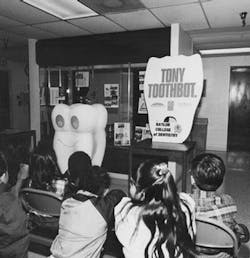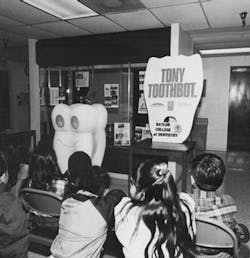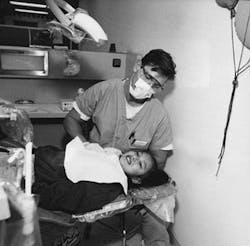An alliance for kids
Seal America charges forward on its goal to apply pit-and-fissure sealants on schoolchildren. Volunteer dental hygienists, though, are needed.
Cindy Quinn, RDH
Most dental hygienists have experienced the disappointment or fear that children express when they learn they have their first cavity. Many have also seen the unnecessary pain and problems associated with caries that go untreated. No one wants to see a child suffer. That?s one reason why Oral Health America?s National Sealant Alliance is beginning to gain recruits within the dental community. Dental hygienists, in particular, have found their participation in the program very fulfilling. It provides an opportunity to expand their role as an oral healthcare professional beyond instrumentation and flossing pep talks in the operatory to worthwhile community service.
According to Denise LeBloch, Vice President of Oral Health America, the National Institute for Dental Research contracted with Oral Health America in 1992 to address the oral health objectives of OHealthy People 2000O, an initiative to improve dental care from the U.S. Public Health Service. One of the listed objectives was to have 50% of children, ages eight through 14, protected with sealants on at least one permanent molar by the year 2000. Oral Health America learned that the Cincinnati Health Department, under the direction of dental hygienist Nancy Carter and Drs. Larry Hill and Mark Seigal, had developed an outstanding school program for placing sealants which was documented as a manual for use in July, 1995. The OHA endorsed the Ohio program as the best model and then formed the National Sealant Alliance to take the application of sealants even further beyond school-based programs.
Oral Health America showcased the Seal America program during its National Sealant Alliance Conference last September. According to the National Program Coordinator, Donald McKenzie, the mission of the National Sealant Alliance is to launch a national plan to increase the demand for and use of dental sealants, thereby improving and protecting the health and well-being of under-served communities. Part of this national plan includes a school program in which dental professionals apply pit and fissure sealants to children?s teeth during the school day.
This program uses mobile dental equipment brought into the school or a bus that transports children to a dental facility. The Seal America program isn?t just limited to protecting teeth from decay. It also recognizes the importance of educating everyone about sealants so parents will ask their family dentist about them and gladly accept treatment. Olympic medalist Jackie Joyner-Kersey is a spokesperson for the program. She plans to promote sealants in several news conferences with the first in under-privileged East St. Louis, a community with only one dentist which is near her hometown. This summer, first and second grade children from this area will receive sealants from volunteer dental professionals using the dental school facilities at Southern Illinois University. Animated public service announcements and an educational comic book for school visits, written in Spanish and English, will also stress the importance of early intervention.
Dr. Larry Herwig spearheaded the first official Seal America program in his role as the 1997 Chairman for the Dallas Mid-Winter Dental Clinic, held last January. He coordinated the efforts of members from the Dallas County Dental Society, Baylor University, the dental meeting, and Oral Health America to provide sealants for 120 under-privileged children in the community. Baylor dental and hygiene students assisted volunteer hygienists and dentists who used the school clinic facilities while dental video tapes and a remote control Molar Robot entertained and educated children waiting for care.
For the Dallas program, the National Sealant Alliance secured product donations from generous contributions made by Kerr, 3M, Oral-B, Dentsply, and Patterson Dental Supply. Says Dr. Herwig, ONo one organization can do this program by themselves. The Dallas County Dental Society hopes that our preventive efforts in the school environment will become a model for the medical community to follow our lead. We need to be proactive.O Ms. LeBloch agrees. She explains that the Oral Health America Consortium works to identify model programs in which the collaborative efforts of dental professionals, private foundations and dental manufacturers, donating funds and product, work together to meet the objectives outlined.
So how does an interested group of dental hygienists set up the Seal America program in their community? National Coordinator Donald McKenzie believes that a three-prong approach is necessary, soliciting the assistance of state, and particularly local public health programs, dental schools, and charitable clinics. Often, the school districts are also very helpful and have insured busses should children need to be transported to a facility. As McKenzie summarizes, OThe teachers have seen kids who have daily pain from their teeth ? pain that distracts them from learning ? so they welcome the program.O For many children, this visit is their first dental experience.
Once the various agencies and facilities agree to the Seal America program in a specific district, the National Sealant Alliance can help to create the program. It can provide educational materials, most of the product for treatment, and consent forms free of charge. The detailed instructional manual for dental professionals, based on the experiences of the Cincinnati sealant program, describes the efficient treatment activities of a well-run sealant program. It is available at no charge from Dr. Bill Hall at the Dental Sealant Resource Center, University of Illinois. Don McKenzie recommends that Seal America programs become part of an actual event such as a state dental convention or a school health fair. It is easier to recruit assistance and publicize the program, initially, when it?s part of something the community already recognizes.
McKenzie cautions that dental hygienists who initiate a sealant program in their area also meet with their local dental society to gain recruits and receive professional blessings for their efforts. OThe people running the program need to make it clear to others in the professional community that they are providing care to children who otherwise would never be able to afford it,O he advises.
Typically, the Seal America team arrives at the school 60 to 90 minutes before the first group of children is seen. They meet with school administrators to determine which children are eligible for care, using the free school lunch program as a guide. Consent forms, sent home to parents well in advance, are secured for each child. They set up the equipment and materials and prepare to teach students about healthy snacks and the purpose of dental sealants. This involves hands-on activities designed for first and second graders that run concurrent to screenings performed by the dental team nearby. If dental caries are present, a note and suggested referral are sent home with the child. If sealants are indicated, they are sent in groups to the mobile dental units or transported to a dental facility.
Donald McKenzie has been diligently working to secure funding for Seal America from several sources ? including Dentsply International, 3M, and the Bureau of Maternal and Child Health ? for the initial resources to get the program started. A two-chair, mobile dental unit costs over $35,000 so most programs must use existing clinics at the onset.
The National Sealant Alliance plans to be fully operational nationwide, by the end of the year. The program bridges the gap between the business and professional world, because the coordination of effort develops skills in project management and creativity, skills not often used in patient care. Begin to contact local agencies, school districts, and the National Sealant Alliance and make Seal America happen later this year.
Cindy Quinn, RDH, BS, is the founder of CreativAtion in Chicago, Ill., a marketing company that specializes in creative communication for the dental industry.
For more information about the Seal America program...
Dr. William Hall
National School-Based Oral Health
Dental Sealant Resource Center (MC922)
University of Illinois
School of Public Health
2121 W. Taylor Street
Chicago, IL 60612
Mr. Donald McKenzie
National Program Coordinator
National Sealant Alliance
8302 East Shetland Trail
Scottsdale, AZ 85258
Oral Health America
410 N. Michigan Ave.
Suite 352
Chicago, IL 60611
312-836-9900
OTony ToothbotO crusaded on behalf of the Seal America program, entertaining 111 elementary school children during the Dallas Mid-Winter Dental Clinic last winter.
The children were pre-selected by a non-profit agency, and sealants were applied by faculty, dental, and hygiene students from the Baylor College of Dentistry. More than 450 sealants were placed during the three-day event.
Photography courtesy of Dr. Larry Herwig.


